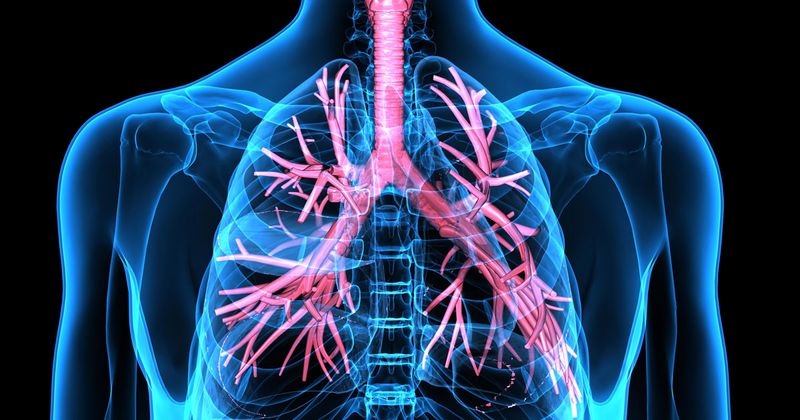Reduced CC16 concentrations in bronchial epithelial cells linked to asthma severity
Key takeaways:
- Patients with severe asthma vs. nonsevere asthma vs. healthy controls had lower CC16 mRNA expression levels.
- CC16 protein may be a possible non-type 2 inflammation biomarker for asthma.
Reduced mRNA levels of club cell secretory protein-16 — an anti-inflammatory protein — in bronchial epithelial cells are linked to asthma susceptibility, severity and exacerbations, according to study results.

“In previous studies of smokers or patients with COPD, club cell secretory protein-16 (CC16) expression levels were greatly reduced by smoking status in addition to genetic factors (the A allele of rs3741240),” Xingnan Li, PhD, associate professor of medicine at the University of Arizona, told Healio. “In this study of nonsmokers with asthma, T2 inflammation may reduce CC16 mRNA expression levels in bronchial epithelial cells, which are associated with asthma susceptibility, severity and exacerbations. Thus, CC16 might be a nontraditional T2 biomarker for respiratory diseases.”

In their study, which was published in American Journal of Respiratory and Critical Care Medicine, Li and colleagues analyzed 242 patients with asthma and 69 healthy controls from the Severe Asthma Research Program (SARP) across two cohorts who underwent bronchoscopy to find out if there is a relationship between CC16 mRNA expression levels in bronchial epithelial cells (BECs) and asthma severity.
Using a generalized linear model, researchers evaluated links between the two factors.
The longitudinal cohort included 42 healthy controls, 52 patients with nonsevere asthma and 62 with severe asthma, whereas the cross-sectional cohort included 27 healthy controls, 78 patients with nonsevere asthma and 50 with severe asthma. RNA sequencing in BECs was conducted in the longitudinal cohort, and microarray mRNA expression in BECs was conducted in the cross-sectional cohort.
Through this analysis, researchers observed a significant association between reduced CC16 mRNA levels and several factors related to asthma: susceptibility and severity, high use of systemic corticosteroids, high retrospective and prospective asthma exacerbations and low pulmonary function.
When looking at asthma susceptibility and severity, those with asthma had significantly lower levels of CC16 than the controls in both cohorts (cross-sectional, 17.9 vs. 18.9 [log2 transformed]; longitudinal, 15.4 vs. 16.3 [natural log transformed]), and those with severe asthma showed reduced levels of CC16 compared with patients with nonsevere asthma (cross-sectional, 17.5 vs. 18.2; longitudinal, 15.1 vs. 15.6), according to researchers.
In terms of lung function in those with asthma, researchers found a significant link between low CC16 levels and reduced FEV1 percent predicted and FEV1/FVC at baseline (cross-sectional, R2 = 0.11; P = .002; longitudinal, R2 = 0.16; P = .0008). Further, patients with asthma and a history of exacerbations within the past year showed decreased levels of CC16 than those who experienced no exacerbations (cross-sectional, 17.5 vs. 18.2; longitudinal, 15 vs. 15.6)
Researchers also noted that over a 3-year follow-up in the longitudinal cohort of patients, they observed a link between low CC16 levels and more prospective exacerbations (RR = 1.75; P = .02).
Additionally, researchers found a significant relationship between decreased CC16 mRNA levels and two T2 inflammation biomarkers: high fractional exhaled nitric oxide (cross-sectional, R2 = 0.13; P = .0003; longitudinal, R2 = 0.063; P = .002) and sputum eosinophils (cross-sectional, R2 = 0.032; longitudinal, R2 = 0.13; P = .0009). Although the P value was not of significance in the latter cross-sectional relationship, researchers called it “borderline significant.”
In terms of Th2 pathway and inflammation genes, including IL1RL1, IL18R1, POSTN, SERPINB2, CLCA1, NOS2, MUC5AC and PLA2G4A, there was a link between decreased CC16 levels and elevated levels of these genes, according to researchers. However, for Th1 pathway and inflammation genes of IL12A, MUC5B, C3, TLR5 and CXCL6, researchers observed a positive correlation between these genes and CC16.
After combining both cohorts of adults with asthma, researchers observed that the following demographics are linked to increased CC16 levels: younger age (P = .0003), non-Hispanic white race (P = .0026) and low BMI (P = .025).
This analysis of all patients with asthma also uncovered several new significant relationships involving low CC16 levels including higher airway reversibility (percentage change in FEV1 percent predicted to albuterol, 25 vs. 16; adjusted P = .004), greater airway hyperresponsiveness (PC20 to methacholine, 0.58 vs. 1.5; adjusted P = .02), worse scores on the asthma control questionnaire-6 (1.61 vs. 0.95; adjusted P = .03), more use of high-dose ICS (61% vs. 40%; adjusted P = .04) and more use of oral/systemic corticosteroids (48% vs. 28%; adjusted P = .02).
It also showed repeated findings from the main analysis, demonstrating that reduced CC16 mRNA levels are linked to worse asthma outcomes and increased T2 biomarkers.
When CC16 was added with interleukin (IL)-6 found in blood, both nontraditional T2 biomarkers, researchers found four asthma endotype groups: high CC16 and IL-6; high CC16 and low IL-6; low CC16 and high IL-6; and low CC16 and IL-6. Depending on what group patients fell into, they possessed varying levels of T2 inflammation, obesity and pulmonary function.
“Asthma is a heterogeneous respiratory disease, and thus, identification of biomarkers (especially non-T2 biomarkers) will facilitate asthma subphenotypes, track disease and personalize medicine,” Li told Healio.
“Future studies are warranted to clarify the causal relationship between CC16 expression levels and T2 pathway genes, asthma susceptibility and severity,” he added. “Importantly, whether serum CC16 protein levels (more practical and noninvasive biomarker) are associated with asthma severity and exacerbations needs to be investigated.”
This study by Li and colleagues demonstrates a potential asthma biomarker, but more studies need to be conducted on this protein to understand how it would operate in this role, according to an accompanying editorial by Brinda Desai, MD, and Praveen Akuthota, MD, of the division of pulmonary, critical care, sleep medicine and physiology at the University of California, San Diego.
“Although Li and colleagues from SARP present a promising airway biomarker, there are still important questions that need to be addressed, including identifying the molecular mechanism of CC16 in asthma and the influence of corticosteroids on its utility as a biomarker,” Desai and Akuthota wrote. “However, the approach itself is an important illustration of the path toward refined asthma endotypes.”
For more information:
Xingnan Li, PhD, can be reached at lixingnan1@arizona.edu or lixingnan1@yahoo.com.
